
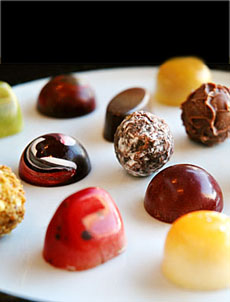
Enrobed chocolates from CafeBlancUS.com.
March 2005
Last Updated October 2012
|
 |
All Types Of Chocolate
Terms & Definitions: D & E
Here you’ll find terms like dark chocolate, dark milk chocolate and drinking chocolate. If you think we should consider chocolate terms and definitions other than those we have provided, click on the Contact Us link on this page. Also enjoy our many other food glossaries.
Click on a letter to go to the appropriate glossary page.
a b c d e f g h i j k l m n o p q r s t u v w x y z
This glossary is protected by copyright and cannot be reproduced in whole or part.
You are welcome to link to it.
DARK CHOCOLATE
Dark chocolate is also known as sweet, semi-sweet or bittersweet chocolate, depending on the chocolate liquor:sugar ratio. Dark chocolate is an eating chocolate that contains 15% to 35% chocolate liquor plus cocoa butter, vanilla, sugar or other sweetener and usually, lecithin as an emulsifier. When expressed as a percentage of cacao on a bar wrapper, dark chocolate has a 50% or higher cacao content. Percentages of 70% or higher are classified as bittersweet chocolate. Who decides if a bar is 50%, 65%, 70% or other cacao percentage? It depends on how the particular cacao bean or blend best expresses itself and what the manufacturer wants to sell (or, what customers want to buy).
|
|
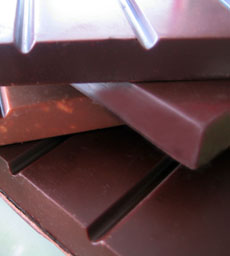
Dark chocolate bars with varying percentages of cacao, from chocolatier Richard Donnelly. Photo by Melody Lan | THE NIBBLE. |
DARK MILK CHOCOLATE
A new category of chocolate which is milk chocolate with a higher than normal percentage of cacao, which gives these chocolates the deep flavor of a semisweet bar with the extra milkiness of a milk chocolate bar. Slitti, an Italian producer, makes a magnificent line called Lattenero (“dark milk”) in 45%, 51%, 62% and 70% cacao. The 70% bar, shown at right, looks as dark as any 70% cacao bar, but contains 2% milk solids so is actually milk chocolate. It has the milky flavor and smoothness without the sugary sweetness, because it is still 70% cacao, 27% sugar and 1% vanilla; whereas the 45% bar is a more traditional milk chocolate recipe with more sugar than cacao. See our reviews of the best chocolate.
|
|
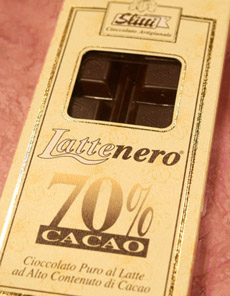
Slitti’s Lattenero line offers milk chocolate with up to 70% cacao concentration. |
DECORATION
The finishing stage of creating a bonbon or praline, where special patterns, halved walnuts or other nut embellishment, piped gianduja, etc. are added to the tops of the chocolates.
DEODORIZATION
A manufacturing process where the cocoa butter’s characteristic chocolate flavors are removed. While quality companies deodorize their cocoa butter to manufacture characteristic white chocolate, this process enables lesser companies to use poor quality and alkali-treated beans, which would produce unpleasant cocoa butter if not deodorized. See cocoa butter.
DESIGNATED ORIGIN CHOCOLATE
Chocolate made from beans from a specific locale. Also called origin chocolate and single origin chocolate. See our reviews of single origin chocolate.
DIAMANT
The French word for diamond, it refers to diamond-shaped chocolates.
DIPPING
Dipping is one of the four basic methods four basic methods of coating chocolate onto a center such as a caramel, nut or fruit; it was the original method of making coated chocolates and is done by hand by artisan producers. The other methods are enrobing, panning and molding or shell molding.
DRAGÉE
Dragées (drah-ZHAY) are sugar-coated almonds, but technically they are almonds encapsulated in a hard-shell coating, which we call Jordan almonds. The almonds can also have a chocolate coating under the sugar. They are a popular wedding favor, representing good luck. The term is also used to describe (2) tiny, round balls of sugar, often coated with edible silver or gold, and used to decorate baked goods; (3) sweet medicated lozenges. The commonality is sugar-coated or sugared. In French, the word also refers to nonpareils and is slang for bullets (small shot). Dragée à la gelée de sucre is a jelly bean.
|
|
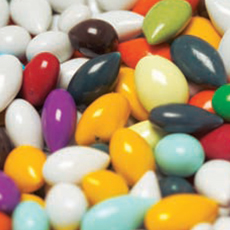 The original dragées were white-sugar-coated almonds. Today, different nuts, seeds and colors are popular. Photo courtesy The Cocoa Room. The original dragées were white-sugar-coated almonds. Today, different nuts, seeds and colors are popular. Photo courtesy The Cocoa Room. |
DRINKING CHOCOLATE
Drinking chocolate is a product used to make hot chocolate. It differs from cocoa powder in that it is not a finely-ground product but bits of actual hard chocolate. It can take the form of shaved chocolate, discs, pistoles or tablets. This term dates back to the invention of the chocolate bar in 1847. Prior to then, all chocolate was consumed as a beverage, and was simply called “chocolate.” With the invention of the bar, the distinction between “drinking chocolate” (which was then only cocoa powder) and “eating chocolate” was made. The term was refined later in the 19th century, when the Swiss began to shave actual chocolate bars to mixed with hot milk or water, making hot chocolate, a richer drink than hot cocoa because of the butterfat in the bar.
|
|
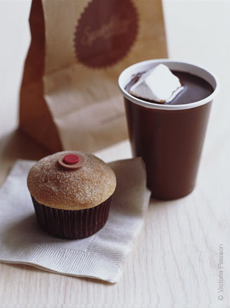
Photo by Victoria Pearson | Sprinkles Cupcakes.
|
DUTCH PROCESS COCOA or DUTCH CHOCOLATE
or DUTCHED CHOCOLATE
Dutching was invented by Coenrad Johannes Van Houten, a chemist in The Netherlands (hence the name, Dutching). In 1828, he patented an inexpensive process for pressing the cocoa butter from roasted beans, creating the press cake that is pulverized into cocoa. Van Houten treated the nibs with alkaline salts (today potassium or sodium bicarbonate [baking soda], originally alkali potash) before they were roasted, to neutralize the natural acidity and bitterness of the typical cacao bean (today, the liquor can be treated prior to pressing). This creates a darker colored cocoa and leads most people to think that Dutched cocoa is more chocolaty. Dutched cocoa is also more soluble, which was Van Houten’s original intent, as natural cocoa does not mix well with water. Because the cocoa is Dutched does not make it better, just different.
|
In fact, the alkali are a processing agent, not a flavor ingredient: The alkali changes the pH of the cocoa, neutralizing cacao’s natural acidity and making it milder in flavor than non-Dutched, natural cocoa (after Dutching, the pH may rise from 5.5 to 7 or 8). Because the pH is changed, you should not substitute the two types of cocoas without making some corrections. Especially in baking, leavening reactions may vary because of the change in the acidity. Note, however, that Dutched cocoa does not mean “the best cocoa.” Cocoa made from superior beans does not have the high acid and bitterness of typical Forastero beans used to make cocoa, and thus does not need to be Dutched. As a result, the inherent fruitiness and full flavor of the cacao bean can emerge. Fine bakers may choose un-Dutched cocoa from top manufacturers to bring out the best chocolate flavors in their baked goods. Scharffen Berger is one producer of top-quality un-Dutched cocoa. If you’re drinking cocoa for the flavanols (anti-oxidants), choose an un-Dutched product: Dutching destroys the phytochemicals. Top quality cocoa generally is not Dutched. As a result, the inherent fruitiness and full flavor of the cacao bean can emerge in the cocoa. Fine bakers may choose un-Dutched cocoa from top manufacturers to bring out the best chocolate flavors in their baked goods. Mass-market cocoa is typically made from high acid and bitterness Forastero beans.
|
|
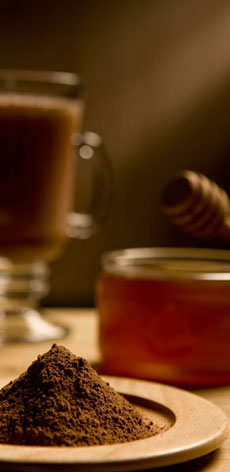
Cocoa powder. Photo courtesy Epullen. |
DUTCHING
The process of making Dutched cocoa from natural cocoa.
EATING CHOCOLATE
Chocolate in bar or other form for eating (as opposed to drinking chocolate, or cocoa, or cooking chocolate). Originally, chocolate was a beverage, made by grinding cacao beans and mixing them with liquid and spices. Over time, cocoa powder was invented and used in cooking as well as beverages. It was not until 1847 that “eating chocolate,” or the chocolate bar, was created.
ENROBING
Covering a chocolate, or the intended center of a chocolate like a ganache interior, with a thin layer of tempered (liquid) chocolate. This can be done by hand or by an enrober, a machine on which the centers (caramels, creams, ganaches, fruits, etc.) travel on a conveyer belt, are showered in a liquid stream of tempered chocolate, and then pass through a cooling tunnel so the chocolate can set. A gentle vibration allows the chocolate to be distributed evenly, giving it that perfect glossy coating. “Robe” means “dress” in French; the enrober is therefore dressing the centers. Enrobing is one of the four basic methods four basic methods of coating chocolate onto a center. The other methods are dipping, panning and molding or shell molding.
|
|
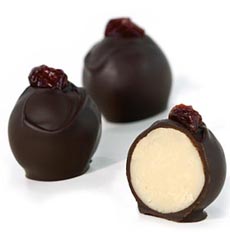
Enrobed chocolates from TheChocolatorium.com. |
ESTATE-GROWN or SINGLE ESTATE
Beans from a single plantation or hacienda.
Continue To Next Page: Terms With F
Go To The Alphabet Index Above
-
-
Lifestyle Direct, Inc. All rights reserved. Images are the copyright of their respective owners.

|










